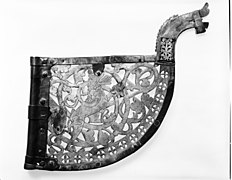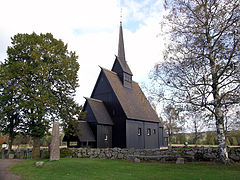Høyjord Stave Church
| Høyjord Stave Church | |
|---|---|
| Høyjord stavkirke | |
 Høyjord Stave Church, Norway's southernmost stave church | |
 Høyjord Stave Church | |
| Location | Høyjord, Sandefjord |
| Country | Norway |
| Denomination | Church of Norway |
| Previous denomination | Catholic Church |
| Churchmanship | Evangelical Lutheran |
| Website | Kirken.no |
| History | |
| Status | Parish church |
| Architecture | |
| Functional status | Active |
| Architect(s) | Uknown |
| Architectural type | Romanesque |
| Style | Numedal type |
| Completed | 1300 |
| Specifications | |
| Capacity | 175 |
| Materials | Wood |
| Administration | |
| Diocese | Diocese of Tunsberg |
Høyjord Stave Church (Norwegian: Høyjord stavkirke) is a stave church in the village of Høyjord in Andebu in the municipality of Sandefjord in Vestfold og Telemark county, Norway. It is the only stave church left in Vestfold County.[1][2][3][4] It is also Norway’s southernmost stave church.[5] It is one of three remaining center post churches (midtmastkirke) in Norway. The stave church is commonly dated to around the year 1300, however, parts of the church were constructed in the 1100s and in 1275.[6]
It is single-naved with a square chancel.[7] It is a Numedal type church constructed in 1200-1300. Restorations were initiated in the 1600s. After World War II it also underwent restoration. The Medieval nave and the chancel’s main structural components are preserved. Its wooden vault over the chancel has been reconstructed.[8]
Description[]
The church was constructed in two different centuries. It has a 12th-century Romanesque chancel and a Gothic nave that was added roughly a hundred years later. It is a single-nave church with twelve posts or staves, all of which are different. It likely had a central mast at one time, which may date to 1690. In 1689, the church was modified and a new ceiling was installed. A central mast of this type was built to symbolize Jesus, while the twelve posts symbolized the twelve apostles. A foundation stone for a central mast was discovered during the 1948-53 restorations. The restoration was led by architect . Medieval discoveries were also retrieved, including a consecration cross, proving the church had been consecrated by the bishop. Traces of decorations in the chancel were also uncovered along with 8-10 consecration wall crosses. In 1960, the church’s altarpiece was restored by .[9]
During the 1948-53 restorations, five preserved skeletons of a man, two children, and two women were retrieved from under a thin layer of soil beneath the chancel floor. The bodies were dated to the time of the Black Death in the mid-1300s.[10]
History[]
The church was built at the end of the 11th century. The church was later removed once and rebuilt. The last reconstruction was completed between 1948 and 1953, at which time major changes were made and the church received the design it has today. The church is also the only remaining stave church in Vestfold county. The church is one of two preserved churches with a pillar or post in the middle. In addition to this central post there are 12 staves, all of which support the building. Each stave has a unique design.[11]
Gallery[]

Høyjord weather vane

Details of the roof


References[]
- ^ Gjerseth, Simen (2016). Nye Sandefjord. Liv forlag. Page 159. ISBN 9788283301137.
- ^ "Sandefjord". 26 April 2019. Archived from the original on 12 June 2018. Retrieved 11 June 2018.
- ^ Bertelsen, Hans Kristian (1998). Bli kjent med Vestfold / Become acquainted with Vestfold. Stavanger Offset AS. Page 113. ISBN 9788290636017.
- ^ Børresen, Svein E. (2004). Vestfoldboka: en reise i kultur og natur. Skagerrak forl. Page 67. ISBN 9788292284070.
- ^ Valebrokk, Eva and Thomas Thiis-Evensen (1993). Norway's stave churches: architecture, history and legends. Boksenteret. Page 77. ISBN 8276830110.
- ^ Lundbo, Sten (22 July, 2021). “Høyjord”. Great Norwegian Encyclopedia. Retrieved on August 24, 2021, from https://snl.no/H%C3%B8yjord
- ^ Hohler, Erla Bergendahl (1999). Norwegian Stave Church Sculpture. Scandinavian University Press. Page 182. ISBN 8200127486.
- ^ Forseth, Terje and Ann Clay Zwick (1997). Norges stavkirker / Norwegische Stabkirchen / Norwegian stave churches. Boksenteret forl. Page 13. ISBN 9788276831689.
- ^ Valebrokk, Eva and Thomas Thiis-Evensen (1993). Norway's stave churches: architecture, history and legends. Boksenteret. Page 77. ISBN 8276830110.
- ^ Valebrokk, Eva and Thomas Thiis-Evensen (1993). Norway's stave churches: architecture, history and legends. Boksenteret. Page 78. ISBN 8276830110.
- ^ "Høyjord stavkirke". Society for the Preservation of Norwegian Ancient Monuments. Archived from the original on 16 February 2018. Retrieved 1 October 2017.
Related reading[]
- Leif Anker (2005) The Norwegian Stave Churches (Oslo: Arfo Forlag) ISBN 978-8291399294
External links[]
| Wikimedia Commons has media related to Høyjord stavkirke. |
- Høyjord Stave Church in Stavkirke.org – in Norwegian
- Stave churches in Norway
- Churches in Vestfold og Telemark
- Culture in Vestfold og Telemark
- Churches completed in 1950
- 20th-century churches
- Tourist attractions in Vestfold og Telemark
- Vestfold og Telemark church stubs





